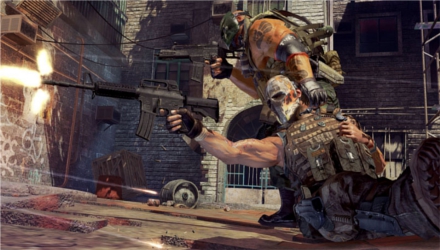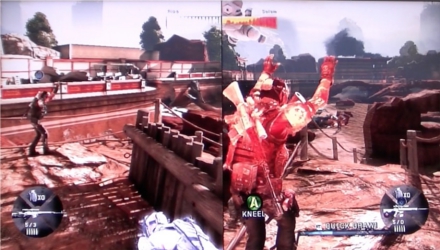Reviews
Review: Army of Two: The 40th Day
February 23, 2010, Author: Trent Pyro
Games are like fashion. Styles come and go; trends go in and out of popularity. It’s a good thing for mind-flitting gamers like myself as it helps us keep boredom locked up ’till lunch. To the untrained eye, it just looks like we’re a fickle bunch of over-active children who can’t decide what we want. However you look at it, games change all the time, and right now gruff, lone anti-heroes are out and buddy squads and teams are in. Army of Two: The 40th Day is no exception.
With the original, EA set something of a trend by building the entire campaign around co-operative play, causing players to either team up with a local or online chum to battle through the carnage, or rely on the ill-fated partner A.I. While it worked for the most part, there were issues. Have EA managed to iron out these creases and provide a solid, exciting and rewarding co-op experience? Have they avoided the cheesy and annoying bromance bullshit that so plagued the original? I think they have, and I’ll tell you why.
Bombers over Shanghai
The game opens with a salvo of current trends. Grainy, Cloverfield-style handicam footage shows us a bustling, modern Shanghai. Buses roar past, people mill about and we catch a glimpse of a plane screaming overhead. Enter trend number one; the titles appear in wake of the plane within the video a la Zombieland. As the camera swings round, it focuses on two hulking, mean looking dudes standing around on the street and boom… cue interesting but overused photoshop effects. A nice freeze frame and our subject’s names: Tyson Rios and Elliot Salem, plastered next to their grimacing mugs. So now we know who the good guys are, but what about the bad?
Boom! Buildings explode in balls of flame, people screaming and running, cars screeching to a stop and hitting lampposts. The 40th Day goes all 2012 on our asses and we get to see the destruction of Shanghai through the lens of a cheap video camera. Our filmmaker, probably feeling a mixture of terror and luck, dashes around to find cover, before being taken out by flying debris. Cue a flashback to before the chaos, and the real story begins.
Think what you want about the unoriginal and highly derivative opening; it gets the blood pumping and sets you up for how the rest of the game will play out. In terms of actual plot, details are thin on the ground. Don’t expect Mass Effect levels of depth and intricacy; Army of Two: The 40th Day is first and foremost about shooting people in the face. Despite a concerted effort to listen to every cut-scene and catch every radio message, it felt like EA scribbled the plot on a napkin in a seedy bar at 2am and never bothered to do a rewrite. \
No bad thing, as many classic action movies have an on-paper plot as thin as a communion wafer, and with about as much flavour. Thing is, we gamers have come to expect twisting, interesting narratives from even the most bloody-minded games, and The 40th Day fails miserably to deliver. Usually I’d rip this tawdry joke of a plot a new exhaust, but considering the nature of the gameplay (in that it’s just so damn fun) I’ll let it slide. Just this once.
Duck and Shoot
Army of Two: The 40th Day, like its predecessor, relies heavily on co-op play. Salem and Rios are a grizzled team, a dynamic duo from way back when. The original threw this in your face by making them chauvinistic, narcissistic pricks. The fist-bumping gorillas have been morphed into hard but thoughtful friends for the sequel, a blessing for those of us who want to play well rounded characters.
Coming in like a pub fight between the original Army of Two and Gears of War, The 40th Day settles for reasonably by-the-numbers cover shooting, grenade lobbing and flanking. The thing that stops this from drowning the game in a sea of existing clichés is the interesting little twists.
Instead of the standard rifle-smack melee attack, you get a plethora of cool and vicious blows and even though the one you execute is random, it helps keep things fresh. A bayonet through the chin and out the top of the head anyone? Cover is handled through an unusual but easy to use combination of a crouch button and an automatic cover system. In some ways it feels more solid and intuitive than Gears and it’s nice to see that someone has at least tried to evolve the aged mechanic beyond its ancient framework. The ‘aggro’ system returns, this time feeling more solid and useful.
For those of you uninitiated, I’ll explain. Let’s say Salem is firing at a group of enemies. They will turn to concentrate on him, and Rios will be free to move around and flank them. Pretty standard, but the difference here is that, whether you have all the aggro or you have none, determines which special co-op options are available. If you’ve got all the flak, you can play dead to shift the attention off you if you start to get pounded. If you haven’t, the enemies will largely ignore you if you stay out of their line of sight, allowing you to set up to snipe or flank with ease. There’s a bit more to it than that, but in my play-through’s I didn’t need to use it with any more depth.
One feature that I personally loved about the original Army of Two was the weapon customization. Every weapon in the game could be ripped apart and redesigned by you, letting you create your perfect signature weapon. I was pretty happy with the range of options they gave me in the first title, but somehow EA have expended this feature beyond my expectations. The range of assault rifles, shotguns and sniper rifles is extensive in itself, but include the massive scope for customizing and swapping-out barrels, stocks, clips and sights, as well as barrel attachments and tons of paint jobs and you’ve got a brilliant system with an almost unlimited number of combinations. Well maybe not unlimited, but you get the idea.

"Come on mate, I only wanted to sit down for five minutes..."
Aside from the shooting, there are set pieces that require tactics and planning to get through. This is where EA’s concerted effort to create a full co-op experience shines. Along with the standard step-jump (“Hey Salem! Give me a boost!”), there’s a set of new actions that are presented in stylish and apparent ways. When one of you aims through a sight, the other can see through said sight via a little on-screen camera window, allowing you to both target different enemies easily. When you’ve both got targets, a quick tap of A will cause you to count down, making effort-saving simultaneous sniping a breeze. If one of you picks up a riot shield, the other can simply tap LB to slide in behind, reaching over to fire on enemies as you both plough through with movable cover. If you go down, your partner can drag you behind cover, while you both continue firing, before healing you back to action. While some of these co-op gems get a little rough as the game wears on, most retain their shine due to the sheer number of them and they’re always realistic and useful in implementation.
This, unfortunately, is where the praise ends. The partner AI, a necessary inclusion for those without Xbox Live or any friends, is well below standard. Sure, it’ll duck and shoot, help you with all the co-op actions and occasionally do what you tell it to (by pressing the D-pad directions) but more often than not it gets itself shot. Not once in my short try with no partner did the AI feel like it was paying any attention to what I was doing. In a game built for two, this level of AI programming is unacceptable, and makes online play a must. While solid, the games main engine is simple. Ducking and shooting holds longer than most, but becomes stale before the game is out.
Salem and Rio’s bromance is toned down but still made me cringe a good few times, and despite the more friendly banter I still couldn’t figure out why these two losers were still working together. Their individual characters are shallow and barely written, simply vocal vessels for their mostly indiscriminate violence. The interesting addition of moral choices (complete with cute comic book cut-scenes showing you how the choice you made plays out) is voided by the nonchalant attitude of the leading men.
Supporting characters are written even more thinly than the stars, leading to pointless feelings in some missions. When Salem and Rio’s controller lady gets kidnapped by the bad guys and it’s up to you to save her before they make strawberry jam of her head, I felt completely apathetic toward her fate. The problem is that, throughout the entire game, all she ever does is bark orders and directions at you. She’s just an annoying voice on the end of a radio telling you what to do. Most games at least bother to give a character in distress some form of fleshing out before they get into said distress. These cracks, while they sound small on paper, run throughout the game, and every so often they annoyingly trip you up.
Shanghai is really nice this time of year…
While not a case of style over substance, Army of Two: The 40th Day looks amazing. A massive leap in quality from the original; every street and corridor is beautifully rendered, with a nice, grungy filter applied to almost everything. Salem and Rios are drawn in much higher detail, and considering they spend much of the game with their warrior masks off, this is no bad thing. Even the enemies, despite their identikit appearances, look great.
The firearms, though, are the real stars here. Every one lights up dank corridors as you pull the trigger, sending barely visible salvo’s of lead careening into the scenery. Damage effects are top quality, with every bullet sending chunks of concrete and plywood flying. Letting loose with an RPG or a grenade launcher has never been so much fun, wooden carts and cars alike bursting into millions of pieces. It’s a showcase of how far damage mechanics have come in the last few years, thinking back to the Geo-mod system of Red Faction on the PS2. Back then, it was a novelty, today it’s the accepted standard, and The 40th Day does not fail to impress. The guns themselves are displayed in fantastic detail. I suspect this was top priority; due to the customization system, each gun had to have enough detail to allow the player to differentiate the parts. Overall, the game looks lush, and occasionally falls victim to looking better than it plays, hats off to the graphics department though.
…but it isn’t very quiet.
Once again, the guns rule here. They boom and crack beautifully, echoing around the environments. Each one has a distinct timbre, making it possible to figure out how heavily your enemies are armed before you can really see them. Explosions rock the scenery, sonic boom effects abound. The cut-scenes in which the city is bombed are made all the better by the fantastic sound effects, making you feel every impact. Footsteps echo in dank corridors, gunfire zips past with alarming volume. The ambiance is exceptional, filling out the expansive areas and making them real. The dialogue is performed well considering the dire script, although the only characters to ever have any personality are Salem and Rios.
…so no one came to the party.
Army of Two: The 40th Day is a co-op game, period. Without a human partner, the AI feels cheap and broken. I’ve talked this through in detail, but there are a few more multiplayer elements that are worth a mention. Barely…

"Don't shoot! I'm nice really!"
Versus is The 40th Day’s excuse for a regular multiplayer mode. Offering standard deathmatch, CTF type matches and domination type stuff; it’s pretty bare when it comes to modes. No matter though; the framework is so bad I doubt anyone will play it for very long. My co-op partner and I got the game maybe a day after release, and after battling through the awful matchmaking system, the frame-stuttering game itself and being kicked by accident numerous times, we found a game almost as inaccessible as Halo 3 for newcomers. Most players have already descended into alternating between rolling around throwing grenades and running around exploiting the one-hit-kill shotgun. It’s like some bastard child of cheap Gears and Halo tactics, screaming and crying and making a nuisance of itself. The 40th Day’s multiplayer is either very much for the elite, or an innocent victim of two-bit gamers who can’t shoot straight and instead employ cheap, overused tactics.
We also experienced severe ‘pwning da n00bs’ moments, something I hoped had been eradicated. Nope, wrong again. It became swiftly obvious to us that we were being targeted, usually with salvo’s of six-or-more grenades with at least three origins. How the opposing teams knew we were newcomers is beyond me. Maybe it was our refusal to stoop to tactical lows, preferring to, ooooh, I don’t know… using the cover system? Maybe it was the fact that you must earn customization options by playing numerous torturous matches, resulting in all new players looking essentially the same. Irrespective of what gave us away, we got the distinct impression we were not wanted. Not a good sign for the future of the mode, or the game in fact.
Maybe we just suck. Maybe the elite will love you all and, after a few games of taking cover and using anything but the shotgun, you’ll start rolling, throwing grenades, running around like headless chickens. Whatever happens, the system is still flawed. Browsing the available games, it’s obvious there is no host migration, causing most matches to have an awful ping rate and terrible connection speed. Games like Modern Warfare and Gears of War implement this system, letting the game pick the person with the best connection to bear the burden of the match. The 40th Day’s blatant disregard for tried and tested methods leaves most matches in lag hell, with players glitching and bugging around getting only lucky kills. Couple this with the bland and uninspired maps and you’ve got a multiplayer that requires effort just to enjoy on a base level. It’s just poor, and it sickens me that in this day and age, a game could get simple multiplayer so very, very wrong.
Granted, this opinion is taken from early experiences. I’m sure the system will iron out its creases, the elite will be overwhelmed by the casual and The 40th Day will soon become a fun and rewarding multiplayer experience. Then again, with so many other multiplayer gems out there, which require little to no commitment to enjoy, I have to ask the question; is anyone going to bother?
Gem scrubbing anyone?
The 40th Day is like marmite. You’ll either love its simple controls, explosive set-pieces and over-the-top shooter action, or you’ll hate it’s blatant disregard for convention, lack of plot and crippled multiplayer. I personally think of it as a flawed gem. The campaign is one of the most polished co-op experiences I’ve ever played, and kept me interested throughout, despite the severe lack of story depth. The multiplayer is broken, but with a bit of polish and possibly some effort on my part, could turn out to be a fun companion the main game. Neat touches like the ability to create and import your own masks elevate The 40th Day above recent, less packed efforts of other third-person shooters. Although it never reaches the breathtaking highs of Gears of War, it also manages to avoid the abysmal lows of trash like Kane and Lynch. Most importantly, Army of Two: The 40th Day is a massive improvement over its predecessor, coming across as a much more enjoyable and accomplished piece of entertainment. If you can look past the flaws, you’ll find a great game and a perfect way to waste a weekend blowing things up.
Problems prevent this from becoming a stone-cold classic, but Army of Two: The 40th Day manges to be a rewarding and enjoyable experience, and occasionally will take your breath away.
Platforms: PS3, Xbox 360 | Tagged Army of Two, bromance, EA, guns, PS3, Rios, Salem, Shanghai, the 40th day, Xbox 360



